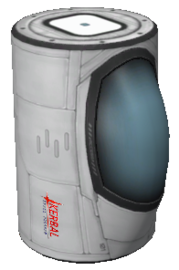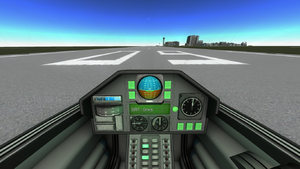Mk1 Inline Cockpit
| Mk1 Inline Cockpit | |||||
| Cockpit by C7 Aerospace Division | |||||
| Radial size | Small | ||||
| Cost | (total) | 1 600.00 | |||
| (dry) | 1 591.00 | ||||
| Mass | (total) | 1.03 t | |||
| (dry) | 1.00 t | ||||
| Drag | 0.08 | ||||
| Max. Temp. | 2000 K | ||||
| Volume | ? | ||||
| Impact Tolerance | 40 m/s | ||||
| Research | | ||||
| Unlock cost | 5 800 | ||||
| Since version | 0.15 | ||||
| Part configuration | mk1InlineCockpit.cfg | ||||
| Command module | |||||
| Pitch torque | 10.0 kN·m | ||||
| Yaw torque | 10.0 kN·m | ||||
| Roll torque | 10.0 kN·m | ||||
| Electricity required for torque |
| ||||
| Crew capacity | (maximum) | 1 | |||
| (required) | 1 | ||||
| Monopropellant | 8 | ||||
| Electric capacity | 50.0 ⚡ | ||||
| SAS level | × None | ||||
| Inventory Slots | 1 slots | ||||
| Volume Limit | 75 l | ||||
The Mk1 Inline Cockpit is a small cockpit with a frontal node for attaching other parts. It is one of the two cockpits thus far that can be stack-mounted (in one size).
Usage
The Mk1 Inline Cockpit is one of two Mk1 (1.25m) cockpit-style command pods (along with the Mk1 Cockpit). They are heavier than traditional command pods (like the Command Pod Mk1), but have higher impact tolerances and better IVA views. While this makes them less useful for spacecraft, they work well for vessels designed to work in atmosphere or land horizontally (like spaceplanes).
Unlike the Mk1 Cockpit, the Mk1 Inline Cockpit has both a front and rear attachment node. These 1.25m radial size attachment points enable placing it inline with such other small parts as RCS tanks, SAS modules, docking ports, air intakes, or a nose cone. This offers far more versatility over the Mk1 Cockpit.
The Mk1 In-line Cockpit features an expansive canopy, allowing a full 360-degree view from IVA. Because of this, it has the best IVA view of any command pod. However, the protruding canopy comes with some drawbacks. The shape increases drag slightly, and does not fit behind a Heat Shield (1.25m).
Like many other parts, the cockpit’s 2000K heat tolerance allows it to survive unprotected recently from low Kerbin orbit. However, faster reentry (such as from an interplanetary return) may overheat the cockpit; capturing into Kerbin orbit before reentry is advised.
Kerbals can enter and exit the Mk1 Inline Cockpit through a ladder built into the left side of the canopy. Since this ladder does not reach the bottom of the cockpit, and since the cockpit usually does not rest on the ground, a separate ladder part (like the Kelus Mobility Enhancer) may be useful.
Instrument Panel
The instrument panel in the Mk1 In-line cockpit is all fully functional. In the centre is the speed indicator which will by default show surface speed. Below that and to the left is the vertical speed indicator and to the right of it is the Radar altitude indicator, which shows height above ground level. At the top is the navball, and below that and to the right is the altometer, which shows height above sea level. On the far right is a bank of 4 indicators and going from top to bottom is the atmospheric indicator, heading indicator, yaw indicator to the right is the pitch indicator and below and left is the roll indicator.
Product description
| “ | A next generation inline cockpit. Designed for sleek high speed aircraft. — C7 Aerospace Division |
” |
Trivia
- The "Rescue" text on the right side of the cockpit resembles the same text visible on the left side of the cockpit of an F-16 Fighting Falcon aircraft.
Changes
- IVA improved
- Remodeled, proper IVA added.
- Renamed from Mk2 Cockpit to Mk1 Inline Cockpit
- Added Electrical power
- Added IVA (basic, no windows)
- Crew capacity reduced from 3 to 1
- Initial Release

